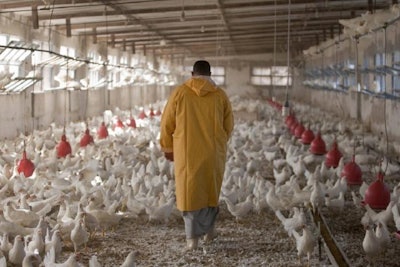
After seeking input from stakeholders in the broiler chicken industry, the USDA’s National Institute of Food and Agriculture (NIFA) and Agricultural Research Service (ARS) have identified 5 priority areas regarding poultry health that the agencies want to emphasize over the next five years.
During the special Animal Health Stakeholder Webinar on Poultry-Broilers held on October 27, the USDA agencies presented five key areas where it would like to concentrate on in terms of research projects and studies. They are:
1. Coccidiosis and gut health
Stakeholders would like to see improved vaccines to prevent and control coccidia and clostridial enteritis. A desire to develop new gut health related products and technologies to replace banned products was also expressed, as well as increased studies to improve the understanding of gut microbiomes in gut health.
2. Antibiotic-free broiler production
As antibiotic-free (ABF) poultry production becomes more common, there is a need to do unbiased studies comparing ABF and conventional production systems and their impacts on broiler health, as well as environmental and economical factors affecting production. The need for studies to determine the effects of ABF production on chick quality and early mortality were also identified. Evaluating alternatives to antibiotics and the development of new products to replace banned ones were also identified as priority areas.
3. Respiratory diseases
The needs for cross-protective vaccines for diseases including infectious bronchitis, infectious bursal disease and avian influenza were identified. Other areas of concern were the need for a less reactive vaccine for infectious laryngotracheitis and the need for a better understanding of emerging viral and bacterial pathogens.
4. Vaccine development and drug treatments
The development of new, improved vaccines to prevent and control diseases in broilers was discussed. One particular area of concern was a more expeditious approval of new vaccines while diseases that can be controlled by the vaccine are prevalent
5. Emerging diseases in broiler production
Histomoniasis and gangrenous dermatitis are both seeing increased incidences, and effective treatments are needed. Other conditions in need of effective treatments are bacterial osteomyelitis of the legs and vetebral osteomyelitis.
Prioritizing broiler health needs and addressing them
Those key five needs were identified from information sought prior to the webinar, which was attended by poultry health professionals in the governmental, commercial and academic sectors. Those participating reached a consensus that the five key areas were prioritized correctly, with the most important concerns at the top of the list.
Bob Smith, NIFA veterinarian and webinar moderator, said the amount of federal budget dollars allocated for pursuing these research initiatives in the upcoming fiscal year has not been finalized, but he added that President Barack Obama has advocated for increased funding for such research.
ARS and NIFA will provide more information on related research initiatives as it becomes more available, Smith advised.


















